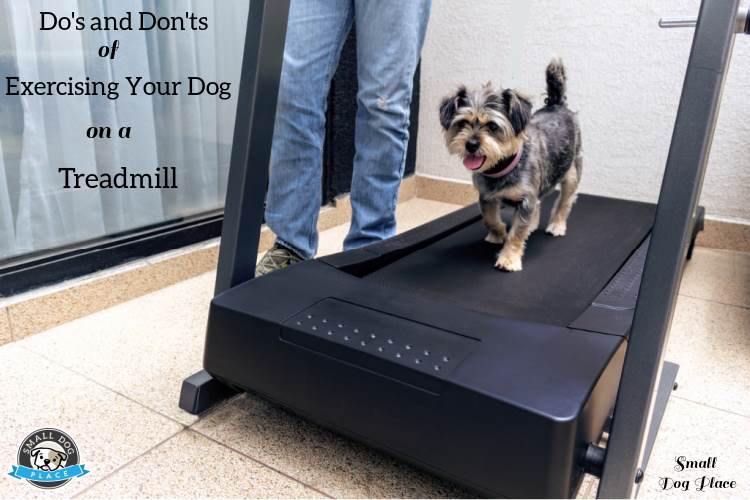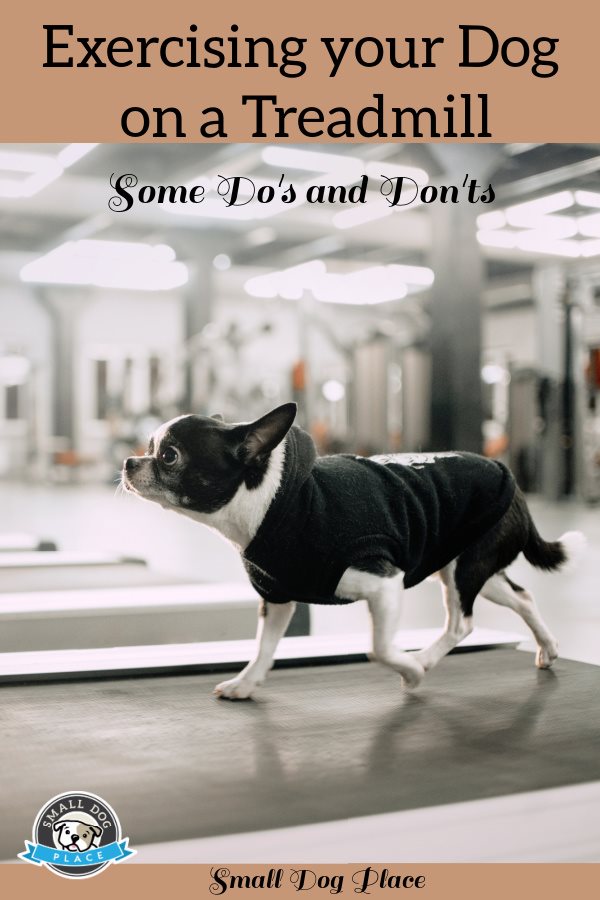Exercising your Dog on a Treadmill: Do's and Don'ts
Exercising Your Dog on a Treadmill by Diane H. Wong |Published 08/19/2020
Most small dog owners are well aware of the the dangers of canine obesity and want to provide sufficient exercise for their favorite little companion.
While a quick walk around the block or a short game a fetch can certainly help, providing enough exercise for high energy dogs may take a bit more thinking. Many dog owners are wondering if a treadmill might be the perfect solution. There are however, some do's and don't to consider.
 Exercising Your Dog on a Treadmill: Some Do's and Don'ts
Exercising Your Dog on a Treadmill: Some Do's and Don'tsOne thing I want to stress is that I write these 'rules' as a guideline for using a human motorized treadmill.
Though there are basically two types of dog treadmill (animal-powered treadmill and motorized), the general rules are almost similar, however, it would be in your best interest to follow the guideline from the dog treadmill manufacturer as opposed to mine.
Misconceptions About Exercising Your Dog on a Treadmill
Again I stress, do not let these misconceptions stop you from exercising your dog on treadmills.
- Treadmills are for the rich.
- Treadmills are for lazy dog owners.
- Treadmills are for dogs with an active lifestyle.
- Treadmills are for large and working dogs.
- Treadmills are for show dogs.
- Treadmills are for dogs competing in obedience trials.
These are not entirely true. As a matter of fact, it is the regular average folks who employ treadmill exercising as an alternative. Only a small percentage of competitive dogs use a treadmill to complement their already rigorous exercise routine.
As with all physical exercises, your goal is to get your dog leading a healthy lifestyle so that he will not be too lazy for his own good.
Exercising your dog on a treadmill regularly not only helps to strengthen the heart muscle and overall well being, but it is also a powerful stress reliever. This is ideal for dogs who are cooped up in the house most part of the day.
Common Sense Rules for Exercising Your Dog on a Treadmill
While these rules may be quite common sense to many but occasionally, they can be overlooked. Always consult your vet before attempting the advanced level like jogging. For a slow pace walking, it should be fine with all dogs with a couple of exceptions.
Don'ts for Exercising Your Dog on a Treadmill
- Place your treadmill with its back against a wall, door, or balcony railings.
- Strap your dog to the treadmill. Especially using a leash tied to the front bar of the treadmill.
- Hold any treats in front of him while he is exercising on the mill. You don't want your dog to leap towards you. Remember, dogs think with their stomachs.
- Place any tempting treats or toys around or above the treadmill. Animals are the worst judges of vertical distance, and they may leap without knowing how high they are. Not very wise to land on a "moving floor"!
- Exercise after a hearty meal even if it is just a 20-minutes brisk walk on the treadmill. Unlike an outdoor walk, your dog does not get to pause occasionally either to investigate or relieve himself. You don't want your dog to experience the uncomfortable feeling of holding his bowel during his workout.
- Exercise right after he woke up from his nap. Cramp usually happens when there is no warm-up before any exercise.
- Start with high speed. Of course, your dog can run, but it doesn't mean he knows how to on a moving belt. You want to start slow, so you don't terrify him on his first attempt.
- Exercise young puppies under 6 months for small breeds and larger breeds under 9 months. Don't boost your dog growth rate as rapid growth can give rise to muscle and bone problems in later years.
- Exercise elderly dogs with existing health issues, especially those suffering from arthritis or joints problems.
- Be too zealous over-exercising your toy dogs, they are not "made" to do tremendous "labor work." Especially dogs with short legs and flat muzzles like Pekingese, Shih Tzu, Dachshund, and Pug.
Years ago, I saw a documentary on television where a Maltese in China could do 200 or 2000 steps of stair-climbing after a tai chi exercise. (I know it's very questionable that a dog can do tai-chi.
The owner never showed how the technique was done as he spoke in Mandarin. Honestly, if this is possible, my late dad would have taught our dogs tai chi instead of 'tormenting' me for years!) with his master every morning. If I'm not mistaken, I believe they are aiming to break the Guinness Book of World Records (for stairs climbing, of course).
Do's for Exercising Your Dog on a Treadmill
- Place a rug right behind the treadmill. This is for cushioning purposes should your dog pause during the exercise.
- Place the treadmill in a well-ventilated room as dogs suffer heat stroke more quickly than humans do.
- Allow your dog to relieve himself before the exercise.
- Start the session no more than 10 minutes and gradually increase by 2 minutes until it reaches 20 minutes.
Once he can briskly walk for a whole 20 minutes, progress it to a higher speed with a gradual increment between 0.3 to 0.5 mph. And if you would like to introduce elevation walking, do it by increasing only 0.5% at a time until 1.5.
- Stay watchful during his exercise, even if your dog has been walking on a treadmill for ages. If you have been exercising religiously, I'm sure you have days where your regular 5-miles-run is too much to handle, and you opt for a 2-miles-run instead.
Likewise, for dogs, they have days where they are not at their top form even if they are physically able. Be flexible to his needs and mood. Gradually shorten the training time when he shows any sign of fatigue after 5 minutes – assuming he does 20 to 30 minutes jog daily.
- Always check the functionality before letting your dog do his exercise. What I usually do is to be the first to use the treadmill before my dogs do. That way, I know if the treadmill needs any conditioning that day.
Some dogs are hypersensitive to creaking sound made by rusty treadmills; they may refuse to exercise further and begin investigating the source. Some might bark at the machine while exercising! It is a funny sight to watch, but your neighbors will not be very pleased with that. =)
- Give a warm rub down after a hard workout. This helps keep the blood moving and reduces the chance of cramps. A brisk 5 to10 minutes massage works wonders. Also, it motivates him to look forward to the next workout session. A treat without calories!
Step-by-Step Treadmill Exercising Guide For Small Dogs
As you read in Part one and two of this treadmill series, you already know the many benefits your dog can gain through the use of it. The next question is how to teach your little poochie to walk on a treadmill?
Before your dog begins exercising on the treadmill, follow the few behavioral guidelines below to ensure your dog's physical and psychological safety.
Behavioral Guidelines for Exercising Your Dog on a Treadmill
- Dogs have the reasoning capacity of a toddler and can become apprehensive or afraid if asked to do something he has never done before.
- Never force a dog to do anything he doesn't want to do. If he feels any fear or hesitation about going on the treadmill alone, then stop. Either try it again later or another day when he is less apprehensive or go back to days 4 and 5.
- Never force a dog to exercise beyond his potential. If your dog is already overweight or obese, don't make him do the whole nine yard—10 minutes of brisk walk followed by 20 minutes of jogging.
It is without a doubt that many small dogs have a lot more energy packed into their tiny bodies compare to sporting dogs. However, breeds like Pekingese, Cardigan Welsh Corgi, or Shih Tzu might find an excursion around the house tiring. Brachycephalic breeds are especially prone to tiring due to exercise.
Other small dogs like Miniature Pinschers, Beagles, Papillons, and Miniature Schnauzers can thrive on long walks. Having said, dogs under 20 pounds are not good candidates for jogging.
Due to the dog's willingness to please, they can somehow keep up the pace, but they certainly are not having any fun. Jogging is best left to medium and large-sized dogs.
Watch Your Dog's Body Language
Supervise all training sessions. Do not put too much stress on your dog that his cardiovascular system is overloaded.
If your dog is showing these signs…
- Continually looking at you — usually the first sign of telling you, "My stamina is about to wear off."
- Lowering his head and tail with tongue hanging out — "I'm gasping."
- Begin slowing down his pace and lagging behind — "I’m trying, but I cannot go on any further.”
- Attempting to put his rear down — “I give up!”
Stop the exercise by picking him up. Gradually put him down so he can regain his regular breathing. Let him have some water to drink before you massage his tiring muscles.
Steps to Introducing Human Treadmills to Small Dogs
Exercising Your Dog on a Treadmill: Day 1 - 2
Do not put your dog on the treadmill the very day you bought the treadmill. Let it sit around for a couple days. Don’t make a big deal about it, treat it like a new piece of furniture you just bought. If he decided to investigate the treadmill, let him be. Again don’t make a fuss about it. Don’t bother to sweet talk to him about it either. Simply go on with your normal daily lifestyle.
Exercising: Day 2 - 3
Let your dog see you exercising on the treadmill. It will help if you are actually enjoying it by starting it slow—brisk walking. While your dog isn’t watching, you may go ahead with your regular workout routine and sweating it out. The reason is simple when your dog, who never exercises in his entire life, sees you pounding the mill and gasping for air, sends him an unpleasant and threatening message. Remember, we’re dealing with pampered pet dogs.
Carry Your Dog: Day 4 - 5
Carry your dog while you are brisk walking on the treadmill. This is only possible if you have small dogs less than 8 lbs. If you have no problem carrying your 10 to 15 lbs dog and brisk walking for 10 minutes, then go ahead with this method.
Do this two to three times a day. (No worries, ladies, you won’t build any arm muscles by carrying your heavy pooch. It takes a whole lot more strength training exercises to build some defined muscles.) The reason for doing this is to get him accustomed to moving motions without diminishing or magnifying the surroundings in any way.
Exercising Your Dog on a Treadmill: Day 6 - 7
Put your dog on the mill and stay a step behind him while both you and your dog walk at a very slow pace. You might be walking at the very edge of the belt if you have a very small treadmill.
Just be careful and bear with it a little, for your focus is more on the comfort and safety of your dog. If this is not possible, you might have to spread your legs and put your feet on the sides on the treadmill next to the moving belt.
Day 7 - 8
Put your dog on the mill at a slow pace. Remain close beside him and continue to “walk” (walking on the spot) on the ground. Do this for 10 minutes or so. Gradually shorten the time as you back away a little but never out of sight. Again, do this two to three a day.
Exercising Your Dog on a Treadmill: Wrap Up
Once he gets the idea of walking on a treadmill, you want to stay close to him until he finishes his 20 minutes walk. Many had asked me if it really takes a week for dogs to get used to treadmill exercising.
In most cases, Yes!
When I first introduced treadmill exercise to my Golden Retrievers (who are with my MIL), they were very cautious of the machine even though it was only a couple square feet larger than them. So looking from your little Fido’s viewpoint, wouldn’t it be scary for him to get on a moving object that’s twelve times his size?
The key to success in training your dog on the treadmill is to go slow.
 Exercising Your Dog on a Treadmill: Do's and Don'ts
Exercising Your Dog on a Treadmill: Do's and Don'tsAbout the Author (Exercising Your Dog on a Treadmill)
Diane H. Wong is a content writer. Besides, she is a research paper writer at the service where everyone can ask to “write my essay for me,” so she prefers to spend her spare time working out marketing strategies. In this case, she has an opportunity to share her experience with others and keep up with advancing technologies.
Did You Find, "Exercising Your Dog on a Treadmill" Helpful?
About Janice (author and voice behind this site)
Having lived with dogs and cats most of her life, Janice served as a veterinary technician for ten years in Maryland and twelve years as a Shih Tzu dog breeder in Ohio.
Her education includes undergraduate degrees in Psychology with a minor in biology, Early Childhood Education, and Nursing, and a master's in Mental Health Counseling.
She is a lifelong learner, a dog lover, and passionate about the welfare of animals. Her favorite breed for over 50 years has been the Shih Tzu, but she has also lived with Poodles, Maltese, Yorkshire Terriers, Beagles, English Bulldogs, Carin Terriers, and a Cocker Spaniel.
When not writing, reading, and researching dog-related topics, she likes to spend time with her eight Shih Tzu dogs, husband, and family, as well as knitting and crocheting. She is also the voice behind Miracle Shih Tzu and Smart-Knit-Crocheting
Does This Article Deserve Your Thumbs Up?
We always appreciate your support and encouragement. Your thumbs up means so much to us. Please like this article.
If you find this page or any page on Small Dog Place Helpful, or useful in anyway, I'd love it if you would click the small heart found on the bottom right of each page.
You can also share or bookmark this page -- just click on the:

Free Monthly Newsletter
Sign Up for Our Free Newsletter and get our Free Gift to You.
my E-book, The Top 10 Mistakes People Make When Choosing a Dog (and how to avoid them)








